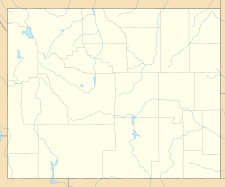Cloud Peak Glacier facts for kids
Quick facts for kids Cloud Peak Glacier |
|
|---|---|
| Type | Mountain glacier |
| Coordinates | 44°23′11″N 107°10′06″W / 44.38639°N 107.16833°W |
| Area | 55 acres (22 ha) |
| Length | .30 mi (0.48 km) |
| Width | .30 mi (0.48 km) |
| Terminus | Scree, Proglacial lake |
| Status | Retreating |
Cloud Peak Glacier is a special glacier located high in the Bighorn Mountains of Wyoming, USA. It is the only active glacier left in these mountains. This glacier sits in a deep, bowl-shaped valley called a cirque. You can find it right next to Cloud Peak, which is the tallest mountain in the Bighorn Mountains. Cloud Peak Glacier is about 11,800 feet (3,600 meters) above sea level.
Contents
What is Cloud Peak Glacier?
Cloud Peak Glacier is a large, slow-moving river of ice. It is found in the northcentral part of Wyoming, a state in the western United States. This glacier is a key part of the Cloud Peak Wilderness area. The wilderness is a protected natural space within the Bighorn National Forest.
Where is it Located?
The glacier is in Johnson County, Wyoming. It's nestled within the Bighorn Mountains, a mountain range known for its beautiful scenery. Its exact spot is just northeast of Cloud Peak itself. This high-altitude location helps the glacier stay frozen for most of the year.
Why is Cloud Peak Glacier Shrinking?
Cloud Peak Glacier is getting smaller very quickly. Scientists expect it might disappear completely between the years 2020 and 2034. This rapid shrinking is a big concern for the environment.
How Do We Know It's Shrinking?
People have taken pictures of the glacier over many years. Photos from 1905 and 2005 show a clear difference. The glacier's size has gone down a lot. It has also become much thinner. In 1905, the glacier was about 506 million cubic feet in size. By 2005, it had shrunk to only 78 million cubic feet. This is a huge loss of ice.
What Happens When a Glacier Retreats?
When a glacier "retreats," it means its edges are melting faster than new snow and ice can build up. This causes the glacier to get smaller and move backward. As Cloud Peak Glacier melts, it forms a Proglacial lake at its end. The melted ice also leaves behind piles of broken rock called Scree. The shrinking of glaciers like Cloud Peak Glacier is often linked to changes in Earth's climate.


